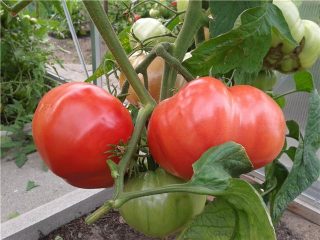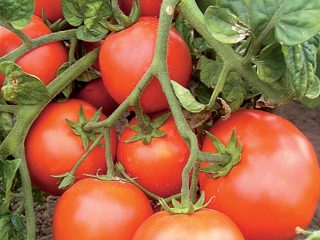Content
The Giant's Dream tomato belongs to a series of elite varieties of Siberian selection. The culture is of indeterminate type, large-fruited, with high nutritional value and tasting value. Tomatoes are consumed fresh; they are also suitable for processing.
History of selection
The Giant's Dream is a variety created in 2015 on the basis of the Federal Scientific Center for Vegetable Growing (FGBNU) located in the Moscow region. The application for admission was submitted in 2017, in the same year the tomato was entered into the State Register with a recommendation for cultivation in greenhouses and film-coated structures in the Siberian and Far Eastern regions. Part of the “Siberiada” series. The copyright holder and distributor of tomato planting material is the Poisk Agrofirm.
Description of the tomato variety Giant's Dream
The Giant's Dream tomato is indeterminate, vegetative type, with intensive growth of green mass. In order for the fruits to be the stated size, it is necessary to remove the side shoots. The bush is tall, the Giant's Dream can reach 2.5 m.This is a tomato variety, not a hybrid, so the seeds are used for further propagation. Plants of subsequent generations fully correspond to the varietal characteristics.
What it looks like:
- stems are hard, coarse-fibrous, of medium thickness, brown in color with sparse pubescence;
- leaf blades are narrow, long, corrugated, jagged along the edge, light green, located on thin petioles;
- flowers are bright yellow, small;
- fruit clusters are simple, with a density of 3-5 ovaries;
- tomatoes are round-flat, strongly ribbed (especially near the stalk), weighing 200-400 g;
- the peel is dense, bright red, not prone to cracking;
- the pulp is juicy, uniform in consistency, with four chambers, without voids. Ripe fruits do not have hard, white segments;
The taste is balanced, sugars predominate, acid is present, but in minimal quantities. The aroma is clearly pronounced.

The plant forms the largest fruits on the two lower clusters.
Characteristics of the tomato Giant's Dream
Like all varieties of Siberian selection, the Giant's Dream variety is distinguished by good adaptation abilities and cold resistance. It is recommended to grow using a protected method, but for regions with warm climates, you can plant tomatoes in open ground. The only problem is the tallness of the bush. A high, fairly stable support that can withstand gusts of wind is required.
Tomato yield Giant's Dream
The description of the variety indicates that the tomatoes are mid-season, but they can also be classified as late. They ripen unevenly even on one hand. The first fruits are harvested four months after seed germination (approximately at the end of July), the last ones - in early October. Fruits vary in weight: from giant to medium size.One tomato Giant's Dream forms up to 2.5 kg per 1 m2 three plants are planted.
Resistance to diseases and pests
One of the advantages of the variety is its immunity to major crop infections. The Giant's Dream tomato does not suffer from: leaf mold, blossom end and root rot, cladosporiosis, fomoz.
With high soil moisture and non-compliance with crop rotation, tomato infection with late blight and fusarium wilt is possible.
Of the pests on the Giant's Dream tomato, only spider mites are parasitic.
How to use
Tomato is classified as a salad variety and is most often consumed fresh. Large fruits are processed into juice, ketchup, added to lecho, and made into purees. Medium-sized tomatoes are quite suitable for whole-fruit canning; they can be included assorted with zucchini or cucumbers. The peel does not crack during heat treatment.
Pros and cons of the variety
The Giant's Dream tomato has many advantages. Gardeners value it for its pleasant taste and high yield. The Giant's Dream variety has other positive qualities.

The harvested crop can be stored in a cool place for no more than 10-14 days.
Pros:
- strong immunity;
- stable fruiting;
- dessert taste;
- cold resistance;
- the peel does not crack due to lack of moisture;
- large-fruited.
The variety has minor disadvantages, common to all indeterminate tomatoes - the need for garter, growth adjustments and removal of shoots.
Features of cultivation
The Giant's Dream tomato is grown as seedlings. To obtain it, seeds are planted in March:
- Mix peat, sand, compost, calcine the substrate in the oven.
- Fill the containers and make grooves 0.5 cm deep.
- If the seeds are collected independently, they are disinfected. The purchased material does not need to be processed.
- Sow at an interval of 5 cm. Cover with soil and water with Energen.
- The containers are covered with film or glass and left for germination at a temperature of +22-25 °C.
- After emergence of seedlings, the covering material is removed.
- When the tomato forms 2-3 leaves, dive.
Tomatoes are planted in the greenhouse in May; if the structure is heated, this can be done in April. To start the growing season, the Giant's Dream tomato needs +4-60 C.
Planting algorithm:
- The area is dug up, organic matter and superphosphate are added.
- Make furrows or holes, add compost mixed with ash to the bottom.
- The Giant's Dream tomato is placed at an angle so that 2/3 of the lower part is in a horizontal position. This method of placement in the hole will allow the tomato to form additional root shoots and provide the tall variety with adequate nutrition.
- Cover with soil up to the first leaves and water.

The interval between plants is 60 cm, row spacing is 40 cm
Required care:
- Form a Giant's Dream tomato with two stems. Periodically remove side shoots, lower leaves, and fruit-bearing clusters. The bush is fixed to a support.
- The tops of the heads are folded at the required height.
- They loosen the row spacing and remove weeds.
- Bushes are being spudded.
- Water twice a week at the root.
When tomatoes enter the stage of technical ripeness, they are fertilized with organic matter.
Pest and disease control

In a greenhouse, Giant's Dream may suffer from Fusarium leaf wilt.
The infection develops when the soil moisture is high.The fungus is in the soil. If the irrigation regime is not observed and preventive measures are not taken, the pathogen begins to multiply quickly, affecting the bush completely. The leaves curl, turn yellow, dry out, a pinkish coating forms near the root collar, this is a sign of the infection moving to the underground part of the plant
Prevention consists of observing crop rotation, treating the soil with copper sulfate, and the seeds with any antifungal agent. If fusarium is detected, problem areas are cut off and the tomato is sprayed with Maxim KS.
On unprotected soil, the Giant's Dream suffers from late blight. The infection develops in late June and progresses until autumn. If measures are not taken, it affects fruits and green mass.

“Oxychom” is effective against fungal infection
Spider mites cause damage to tomatoes in a greenhouse. The insect feeds on the sap of leaves and weaves webs around the localized areas. The tomato weakens, growth stops, and the ovaries fall off.

Get rid of pests with Iskra Bio
Conclusion
Tomato Giant's Dream is an indeterminate, cold-resistant variety with good adaptability. Recommended for indoor growing in greenhouses. Salad variety, with a high gastronomic rating, universal in use, large-fruited. For canning, tomatoes from the upper trusses are used; they are smaller.
Reviews from gardeners about the Giant's Dream tomato









